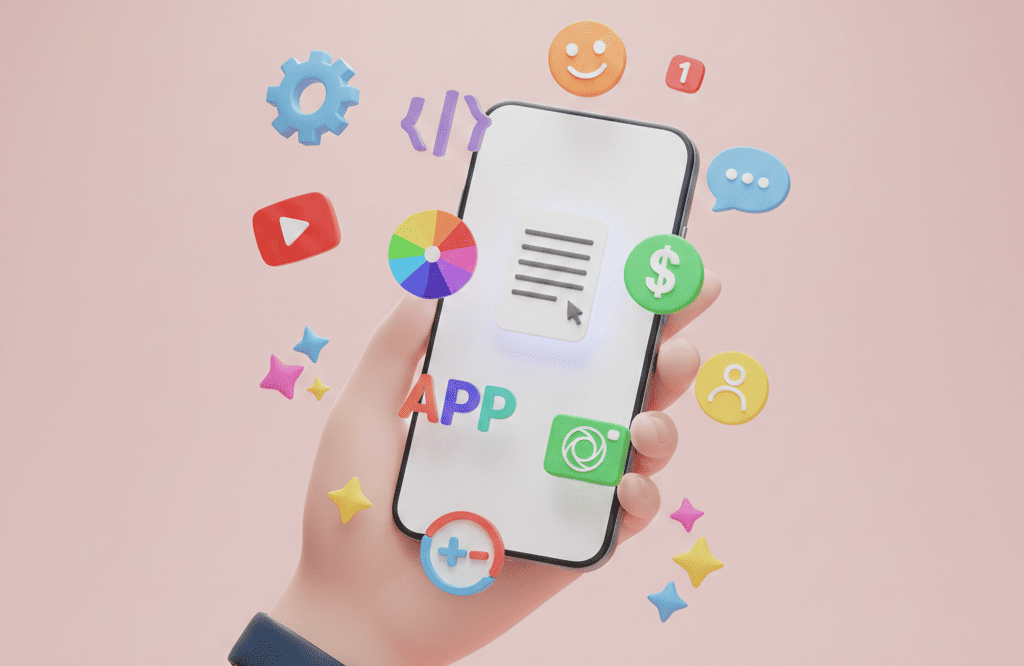The idea that creating a phone app is a complex endeavor reserved exclusively for expert programmers is a persistent myth. In today’s technological landscape, that notion is simply outdated.
With modern tools and platforms, anyone with a great idea has the power to bring a functional, professional-looking application to life.
To do this, you have two primary paths to bring your app to life: leveraging a user-friendly no-code mobile app builder or taking the traditional path of coding from scratch.
If you’ve ever wondered how to create a phone app, this guide provides a clear, step-by-step roadmap to navigate the process and turn your concept into a reality.
From a Great Idea to a Solid Plan
Before you can build anything, a successful app must begin with a well-defined idea and a solid plan. This strategic planning phase is crucial for standing out in an increasingly competitive market.
According to Statista, users downloaded 218 billion mobile apps in 2020 alone, highlighting the immense demand and the need for a clear vision to capture user attention.
To transform your initial concept into a viable project, start by answering these fundamental questions:
- Who is your target audience? Your app must be designed to add specific value to the users you intend to serve.
- What features are most desirable? Identify the core functionalities that will solve a problem for your users and keep them engaged.
- Who are your competitors? Research other apps in the market that address a similar concept. Analyze their user reviews to understand their strengths and weaknesses, and find opportunities for your app to improve on the experience.
- How will you monetize your app? Determine your business model. Will it be a paid app, freemium, ad-supported, or subscription-based?
Once your goals are set, the next critical element is app design. Research has shown that a user decides whether to stay on a screen or leave in as little as 500 milliseconds. This decision is heavily influenced by the app’s visual design and user experience.
App design is a combination of two interconnected disciplines: User Interface (UI) and User Experience (UX).
- UI (User Interface) refers to the visual, graphical elements that users interact with. This includes everything from icons, colors, fonts, and logos to navigation menus and background illustrations. A simple and consistent UI is key to success.
- UX (User Experience) encompasses the overall quality of the user’s journey. It involves aspects like loading speed, responsiveness, ease of navigation, and the number of clicks required to achieve a goal. A positive UX is what makes an app feel intuitive and enjoyable to use.
A great way to start visualizing your app is to create a mockup, beginning with simple sketches called wireframes. Wireframes are basic outlines that help you focus on the essential parts of your interface and define the core features of your Minimum Viable Product (MVP).
As you sketch, keep the “3-click rule” in mind as a practical goal: users should be able to find any information within three clicks.
This process makes it easier to place key components and test the flow of your app before committing to a final design. With a clear plan and a visual sketch in hand, you are ready to make the first major decision in your app creation journey.
No-Code vs. Traditional Coding
With your app idea thoroughly planned, the next critical step is to select the right development method. This choice is primarily between accessibility and control, and for a beginner, it has major strategic implications.
Your decision will determine your budget, timeline, and ability to iterate quickly. You have two primary options: using a no-code platform or learning how to make an app with coding.
The no-code revolution: using a mobile app builder
For beginners and entrepreneurs, the no-code path is not just easier—it is the superior strategic choice for validating an idea quickly and with minimal financial risk.
A no-code mobile app builder is a software tool that allows you to create a phone app without writing any code.
Similar in concept to how website builders like WordPress empower users to create websites, these platforms provide a visual, drag-and-drop editor that lets you see your app come to life in real-time.
This is an ideal option that saves a significant amount of time and money while still achieving a high-quality, professional app.
This approach is also the most direct answer to the question of how to make an app for free, as it is a vastly more cost-effective option than hiring an agency or freelance developer.
The traditional path: how to make an app with coding
The traditional method involves writing source code using a programming language. While this path offers maximum control and customization, it requires technical expertise, is far more time-consuming, and is the most expensive option.
- For iOS Apps, the modern programming language for creating iOS apps is Swift. Developed by Apple, Swift is a powerful language designed to be easier for new programmers to learn. It offers the performance of older languages like C and Objective-C without their complexity, making it the standard for today’s Apple apps.
- For Android Apps, Google supports a range of programming languages for Android development. The primary options include:
- Java: The best-known and most widely used language for Android apps.
- Kotlin: Fully compatible with Java and integrated into Android Studio, Kotlin is gaining popularity.
- C++ & C#: These languages are also available and are typically used for specific functionalities for which you need the greatest possible control over hardware.
For those just starting, the no-code path provides the most accessible and efficient way to build and launch an app. The remainder of this guide will focus on that strategic approach.
A 7-Step Guide to Creating Your App (The No-Code Way)
For beginners, entrepreneurs, and anyone without a programming background, using a no-code mobile app builder is the most direct path to a successful launch. It’s a strategic decision that prioritizes speed, cost-efficiency, and market validation.

This section breaks down the entire app creation journey into seven simple, actionable steps.
Step 1: Define your app’s goals and design
Before you touch any software, get your idea on paper. Synthesize the foundational work from the first section of this guide by clearly defining your app’s purpose, identifying your target audience, and researching competitors.
Sketch a simple wireframe of the main screens to establish the basic layout and user flow.
Step 2: Choose your app type: native vs. PWA
A crucial technical decision is whether to build a Native App or a Progressive Web App (PWA). Your choice here has strategic implications.
If your primary goal is discoverability on search engines and reaching the widest possible audience quickly, a PWA is a powerful option.
If your app relies heavily on device-specific hardware (like advanced camera functions or geofencing), a Native app provides the most robust performance.
| Feature | Native App | Progressive Web App (PWA) |
| Definition | A software application developed for a specific operating system (iOS or Android). | A hybrid of a regular web page and a mobile app that uses web features. |
| Distribution | Published and downloaded via app stores (Apple’s App Store, Google Play Store). | Does not require a store publication; accessed via the web. It can be installed on the home screen. |
| Performance | Offers reliable and high performance with access to device hardware and software. | Performance is browser-dependent. |
| Reach | Accounts for over 80% of all mobile traffic. | Gets 3x more visitors than a native app and benefits from SEO. |
| Offline Access | Can utilize device features for robust offline functionality. | Works offline thanks to Service Workers. |
Step 3: Build your app with a no-code builder
This is where your vision starts to take shape. Using an app builder’s visual editor, you will select design templates, add your content, and incorporate advanced features to bring your app to life. The typical process involves:
- Design: Choose a global color theme, header style, and navigation mode that aligns with your brand. Spend time designing an engaging home page that showcases your most important features and provides fluid navigation to different sections.
- Content: Add your content either by entering it manually or by integrating external sources like an RSS feed or social media accounts. This content is organized into sections, such as articles, videos, photos, or events.
- Add-ons: Enhance your app’s functionality by incorporating add-ons. Popular features include Loyalty Cards, Couponing, Push Notifications for direct communication, or a Chat feature to build a community.
Step 4: Test your app thoroughly
Before publishing, it is critical to test your app on both iOS and Android devices to ensure a flawless user experience. A comprehensive test should check for the following:
- Overall app speed and performance, especially in conditions with poor connectivity.
- The app does not crash when a user performs any action.
- Navigation is intuitive, efficient, and not confusing.
- The design is visually pleasing and correctly adapted to all screen sizes.
Step 5: Publish to the app stores
Once testing is complete, it’s time to submit your app for publication.
- Apple’s App Store has a slightly complex review process with high standards to ensure a safe and high-quality ecosystem for its users.
- To make a free app for Android available, you must publish it on the Google Play Store, which also has its own set of review rules to follow.
- Publishing a PWA is much simpler. It only requires hosting the app on a web server and linking it to a domain name.
For beginners who find the submission process daunting, it’s important to note that some mobile app builders offer services to manage the complex store submission process for you, removing a significant technical hurdle.
Step 6: Launch and market your app
A successful launch requires more than just publishing. It’s often a good strategy to hold some features back for future updates; this gives users a reason to stay engaged and look forward to new releases.
Crucially, an app without a marketing plan is invisible. Your launch strategy should be designed to create initial momentum and attract your first crucial users, whose feedback will guide your app’s future.
Step 7: Improve and update continuously
Creating an app is not a one-time project; it’s an ongoing process. After launch, it is essential to monitor user feedback and track your app’s Key Performance Indicators (KPIs) using analytics tools.
This data will provide invaluable insights for making continuous improvements and releasing updates that meet the evolving needs of your users. Doing so allows you to build a loyal community and increase long-term retention, which are key drivers of app success.
FAQs
Here are answers to some of the most common questions from aspiring app creators.
While building a fully professional app completely for free is rare, the most accessible way to start for free or at a very low cost is by using a no-code mobile app builder. These platforms are significantly more cost-effective than hiring a developer, and many offer free trials or affordable entry-level plans that allow you to begin building your app right away.
The “best” builder ultimately depends on your specific project needs. However, a great mobile app builder will provide a visual drag-and-drop editor, a wide range of professional design templates, and a catalog of add-ons to enhance functionality.
Features to look for include loyalty cards, push notifications, and chat capabilities. Platforms like GoodBarber offer these features to help you create a powerful app.
Making an app with coding involves writing the application’s source code in a programming language.
– For iOS apps, the modern language of choice is Swift.
– For Android apps, the most popular languages include Java and Kotlin, which are growing in popularity.
This traditional method offers the most customization and control but requires deep technical skill, a significant time commitment, and a substantial budget.
Yes, you can create an app for Android, and there are very cost-effective ways to do it. The most straightforward method for a beginner is to use a no-code platform.
This allows you to make a free app for Android (or at least do so very affordably) before you publish it to the Google Play Store for users to download.
Conclusion
The journey of app creation, once a complex and exclusive field, is now more accessible than ever. The central message of this guide is simple: with the right tools and a clear plan, anyone can create a phone app.
The rise of powerful no-code builders has democratized development, empowering you to turn a great idea into a tangible product that can increase your brand awareness and help grow your business.
Your idea is the blueprint. The no-code tools are ready. The time to start building is now.





